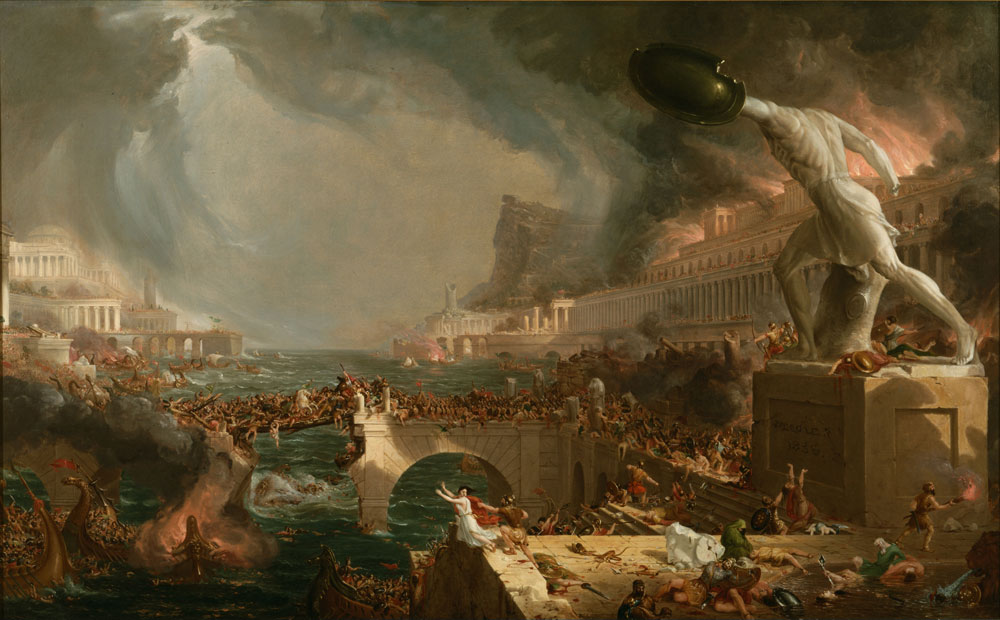The Course of an Empire. Rise and fall of Rome, climate change effects.

The Course of an Empire.
At one time or another, every Roman historian is asked to say where we are, today, in the cycle of the fall of Rome. Historians may try to use the past, but even if history does not repeat itself and does not engage in moral lessons, it can touch our sense of what it means to be human and also how fragile our societies are.
In the middle of the second century, the Romans ruled a large geographically diverse part of the globe, from northern Britain to the ends of Sahara, from the Atlantic to Mesopotamia. Generally prosperous population reached 75 million. Eventually, all the free emperor's inhabitants came to enjoy the rights of Roman citizenship. It is no surprise that 19th-century English historian Edward Gibbon appreciated this happiest age in the history of our species - yet today we are more likely to see the progress of Roman civilization as planting its seeds of death.
Five centuries later, the Roman Empire was a small Byzantine state controlled by Constantinople, its eastern provinces, lost by Islamic conquests, western lands covered by a variety of German kings. Commerce pulled down, cities shrunk, and technological progress stopped. Despite the cultural vitality and spiritual heritage of these centuries, this period was characterized by a declining population, political fragmentation, and lower levels of material complexity. When historian Ian Morris at Stanford University created a universal index of social development, the collapse of Rome appeared as the biggest obstacle in the history of human civilization.
Explanations for a phenomenon of this magnitude are abundant: in 1984, German classics Alexander Demandt cataloged more than 200 hypotheses. Most scholars have seen the inner political dynamics of the imperial system or the geopolitical context of an empire, whose neighbors gradually caught up in the sophistication of their military and political technologies. But new evidence is beginning to reveal the crucial role played by changes in the natural environment.
Climate change did not begin with the fumigation of industrialization, but it was a permanent feature of human existence. Orbital mechanisms (small variations in tide, rotation, and eccentricity of the Earth's orbit) and solar cycles vary the amount and distribution of energy received by the Sun. And volcanic eruptions throw reflective sulfate into the atmosphere, sometimes with long effects. The modern change of anthropogenic climate is so dangerous because it is happening quickly and in connection with other irreversible changes in the Earth's biosphere. But climate change in itself is nothing new.
The need to understand the natural context of modern climate change has been an undeniable relief for historians. Earth scientists have painted the planet for paleoclimate proxies, natural archives of the past environment. Attempting to put climate change in the first plan of Roman history is motivated by new findings and an increased sensitivity to the importance of the physical environment. It turns out that the climate had a major role in the growth and decline of Roman civilization. Empire builders benefited from time immemorial: warm, humid, and weathering weather was conducive to economic productivity in an agrarian society. The benefits of economic growth supported the political and social bargains with which the Roman Empire controlled its vast territory. The favorable climate, in subtle and profound ways, grew in the deepest structure of the empire.
The end of this fortunate climate regime did not immediately, or in a simple deterministic sense, the magic of the punishment of Rome. On the contrary, a less favorable climate damaged its power only when the empire was endangered by the most dangerous enemies - the Germans, the Persians - from abroad. Climate instability culminated in the sixth century, during Justinian's rule. Work by dendro-chronologists and leading ice experts shows a major eruption of volcanic activity in the 530 and 540 EC, unlike anything else in the last thousands of years. This violent order of explosions caused what is now called the "Late Antique Lesser Age" when the colder temperature lasted for at least 150 years. This phase of climate deterioration had decisive effects on the resolution of Rome. She was also closely linked to a catastrophe of an even bigger moment: the outbreak of the first pandemic bubonic plague.
Interventions in the biological environment were even more important for Rome's fate. For all the premature advances of the empire, life expectancy lasted in the mid-20s, with infectious diseases the main cause of death. But the sphere of illnesses touched by the Romans was not static, and also the new sensitivities and technologies are radically changing the way we understand the dynamics of evolutionary history - both for our species and our allies and our microbial opponents.
Our world is now very different from ancient Rome. We have public health, embryo theory and antibiotic pharmaceutical products. We will not be as helpless as the Romans, if we are so wise enough to know the severe threats that lie around us and use the means available to mitigate them. But the attitude of nature in the fall of Rome gives us reason to review the power of the physical and biological environment to break the fate of human societies. Perhaps we can come to see the Romans not as much as an ancient civilization, standing in an impassable partition from our modern era, but rather as the creators of our world today. They built a civilization where global networks, contagious developing diseases and ecological instability were the decisive force in the fate of human societies. The Romans also thought that they had the upper hand of the unstable and angry power of the natural environment. History warned us but they were wrong.